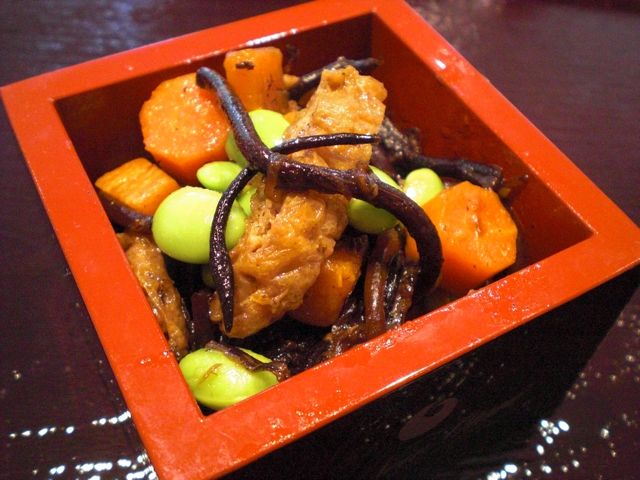Hijiki ひじき is one of the several "kaiso" 海藻 or sea vegetables (sounds better than "seaweed") which has been a part of Japanese cuisine for a long time. Japanese consider hijiki to be a healthy food with high fibers and minerals. As I was growning up, we had hijiki occasionally, but it was, by no means, my favorite dish as a kid. It does make a nice small dish for a drink, however, and as such, I like hijiki now. (Regarding arsenic contained in Hijiki, please refer to the footnote.)
Hijiki comes dried and usually has two different kinds; "Me-hijiki" 芽ひじき consisting of the buds or tips of hijiki, and "Naga-hijiki" 長ひじき consisting of the stalks of hijiki. I happened to get dried "Naga-hijiki" and decided to make two dishes. In dried form, hijiki is very hard and black like tangles of black metal wires. To prepare, after washing in cold running water in a colander, I soak it in large amount of cold water initially for 30 minutes. At the end of the 30 minutes, the volume of hijiki increases something like 10 fold and you can see the dark brown shapes of the original hijiki plant with the fresh smell of the ocean. I drain and wash in cold running water in a colander. I then soak again in fresh water. I repeat this several times over the period of about 2 hours (you do not really need this long soak and changes of water but I like to leach out as much of the small amount of arsenic as possible, see the footnote). If I am not ready to cook this immediately I keep it in a container with water and place it in the refrigerator.
1. Hijiki and chicken salad ひじきと鶏肉のサラダ
Since I had some leftover cooked (barbecued) whole chicken, I used the breast meat for this dish. If you are making this from scratch, you should either steam in sake or "sakamushi*" 酒蒸し or microwave the chicken breasts.
*add 2-3 tbs of sake in a small frying pan and add a chicken breast (skin removed). Put on a tight fitting lid and braise/steam for 4-5 minutes or until the chicken is done in a low flame.
In a small frying pan, add olive oil with a dash of dark roasted sesame oil. When the oil is hot, add a desired amount of hydrated and drained hijiki and saute for 1-2 minutes and then add coarsely shredded (by hand) cooked chicken breast and saute for aother minute and season with salt and pepper. Tip them out in a bowl and add soy sauce with dissolved
yuzukosho 柚子胡椒 (from the tube) or wasabi. You could also use ponzu (soy sauce) ポン酢醤油 with or without the spicy stuff. Here, I made a half and half mixture of soy sauce and yuzukosho and added the mixture in several increments as I tasted it to my liking. I garnished it with cooked and shelled edamame. I serve this at a room temperature. This is a good dish. Mild zing and flavors of the yuzukosho is very nice.
2. Stewed Hijiki ひじきの煮物
This is as classic as hijiki dishes go. There are many variations to this. Some add cooked (yellow or ripe) soy beans "mizuni daizu" 水煮大豆 and other vegetables. Carrot and deep-fried tofu pouch "
abura-age" 油揚げ are most common ingredients in this dish. I used carrot, sweet potato,
edamame 枝豆 and deep fried tofu pouch in mine.

I made a large batch with the remaining prepared hijiki which is about 3 cups after hydration. I added broth (I used granulated instant "dashi" dissolved in water) (1 cup) add small cubes of carrot (one large) and sweet potato (1/2 large) and simmered for 10 minutes or until vegetables were cooked (not too soft) and set it aside in a bowl with the liquid. I added peanut oil (1tbs) with a dash of dark sesame oil in a sauce pan on a medium flame and saute the prepared hijiki and thin strips of abura-age (2 small squares or "koage" 小揚げ, blanched, squeezed of water and cut into thin strips) for 1-2 minutes and add the cooked vegetables with its liquid. Simmer for 5 minutes and I season it with sake, mirin and soy sauce (1:1:2 parts), I will go easy on soy sauce at first since it will cook until the liquid is almost all gone. I taste when the dish is almost done and add more soy sauce if needed (I did not). After turning off the heat, I mixed in cooked and shelled edamame and let it sit and come to the room temperature before serving. This has a classic taste of hijiki "nimono" dish. I found old "ichi-go
Masu" 一合升 in the back of the kitchen cabinet and used it to serve this dish.
We had both hijiki dishes at one sitting. Both dishes are quite different in taste and texture (although it may look similar) and went well with cold sake.
*Footnote regrading arsenic in Hijiki:
I did not know this until I read
Hiroyuki's blog some time ago. It appears that the amount of inorganic arsenic is not high enough to have a serous health concern if you consume hijiki in moderation (meaning not eat tons of hijiki everyday). There is no known case of arsenic health effects even in Japan where people tend to eat more seaweed than anywhere else including hijiki. It is also reported that If you soak hijiki for 1 hour and if you boil it for 5 minutes after hydration,
. This time, I soaked much longer than needed with multiple changes of water which, I am surmising, reasonably reduced the arsenic content. So it appears that consuming hijiki cooked this way is not to be of any health concern.
A (professional) well-informed Japanese food blogger appears to take a similar position.
